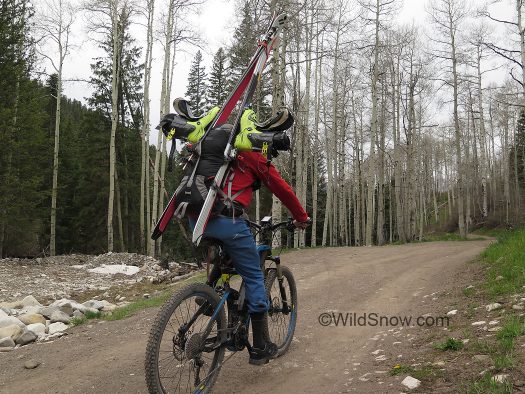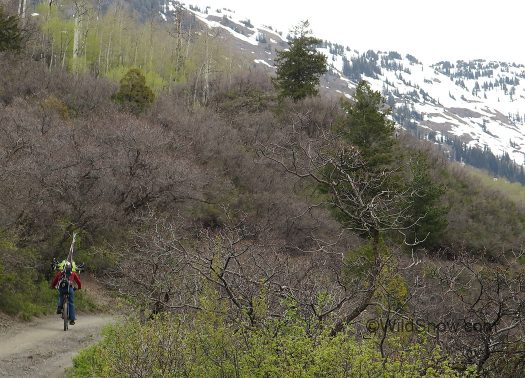We’ve been testing a couple of e-bikes, current steeds being being high-end Haibike mountain bikes powered by “pedal assist” motors goosed with big lithium-ion batteries mounted on the down-tube. After seeing the e-bike craze in Europe during our long spring and summer stint there a year ago, we’ve been keen to purpose e-bikes to solving the ski touring access problems we have here in Colorado, due to springtime roads becoming wheel navigable but gated to automobile traffic — or simply too rough to drive with anything but a real 4×4.
(Motorcycles can be a solution as well. I’ve used motos a few times for access, problems are they’re not stealthy and they’re difficult to schlep over snowbanks and rocky areas that are too difficult to ride while hauling baggage. ATVs (4-wheelers) are also an option, but they’re too similar to a regular automobile and can thus bring down the wrath of the man, as well as being difficult to lift over or drag under gates.)
Conclusion: E-bikes are IT. While the battery does limit your range (these are heavy machines, you’re not going uphill very far once you’re out of power), for most approaches we’re dealing with we seem to have plenty of juice — especially when most returns are downhills. Fire up the electrons, you can do some stiff, lengthy uphills or many miles of moderatly angled dirt or pave.
In my estimation, assuming you can coast back down, these Haibikes could reliably climb a moderatly angled mountain road or trail for around 10 miles at mid-range power settings, with attention to conservation such as not using pedal assist on flat sections. Fit riders willing to use more leg power can extend that range indefinitely, or at least until they run out of glycogen.
A few challenges have come up in our testing. The big one is how to carry skis and gear without pedaling with a loaded rucksack on your shoulders. In theory, wearing a backpack with A-framed skis and clipped boots seems like it would work. But I’m finding doing so to be extremely hard on my back and shoulders, especially on steep downhills when the weight of the pack is like a pile driver slamming between my shoulder blades. Remember, use one of these things and you might be covering way more distance than you normally would on a bicycle — with subsequent wear and tear on your body due to the lengthy downhilling required for your return journey.
Some sort of bike frame mount for at least the skis might be the ticket, or perhaps even a lightweight bike trailer holding both skis and backpack. The trailer might work especially well on pavement. I know some of you readers use bicycles for access, how do you carry all your stuff, just tough it out?
The other frustrating e-bike challenge reminds me of those times you see a cool automobile in Europe, and find out it’s not available in the U.S. because of “regulations.” Well, the same lame stuff is going on with e-bikes. Namely, e-bikes in Europe can have a “walk assist” feature that’s the ticket for slow journeys uphill in rough terrain or doing things like stream crossings. Hike-a-bike with a little help. My understanding is that e-bikes sold in U.S. can’t have walk assist. I have no idea of the technicality behind this, but remember these bikes are “pedal assist” powered, meaning you have to apply human power to the pedals before the motor kicks in and helps. Perhaps walk-assist makes the bike a fully powered “scooter” in the eyes of the regulators, invoking all sorts of red tape?
The Bosch and Yamaha pedal assist motors on these bikes are amazing. They’re easy to operate and clearly efficient. For extended range you could bring a spare battery, but they weigh about 2.6 kg and I don’t even want to know how much they cost. Water resistance is also an issue. It’s a bicycle so one would assume everything will be fine in extended wet weather, but our research indicates you don’t really want to submerge the motor, say during a stream crossing. We have wade crossings in Colorado that would certainly wash water up over the motor housing, and there is always the chance you could trip during a wade and let the bike fall over on its side.
In any case, other than the weight of these full featured downhill monsters with electric motors and batteries (getting them in and out of the truck took some thought), they’re simply one of the coolest things we’ve come across in our long history with bicycles. If you live in a place where access is limited by restricted automobile access, worth a look.
And yes Virginia, there is indeed some controversy about how e-bikes fit into the greater scheme of human powered enlightenment. Wildsnowers, I’d love to hear your opinions on that. But more, do you think e-bikes will solve the access problem many skiers in our fair land are frustrated by?
(Note: A vast variety of electric bicycles are available. Some are apparently even fully powered without pedaling. The pedal-assist type motor seems much less likely to engender hate from purists and is perhaps farther away from being against the rules on some paths and trails. It’ll be interesting to watch this. For those of you who’ve never ridden one of these, you do get a workout as you have to apply pedal torque to trigger the assist. The level of power is controlled from a selector unit on the handle bars, from a barely noticeable level that basically takes care of the bike’s weight, all the way up to “turbo” that zooms you up the trail amazingly fast but sucks down the battery as you watch. The electrical assist is speed limited as well, though hackers have already figured out numerous ways to bypass that annoyance.)
Of interest, conversion kits are available. Re-purpose that old mountain bike you never sold after an upgrade? Here is one kit that looks interesting.
WildSnow.com publisher emeritus and founder Lou (Louis Dawson) has a 50+ years career in climbing, backcountry skiing and ski mountaineering. He was the first person in history to ski down all 54 Colorado 14,000-foot peaks, has authored numerous books about about backcountry skiing, and has skied from the summit of Denali in Alaska, North America’s highest mountain.


